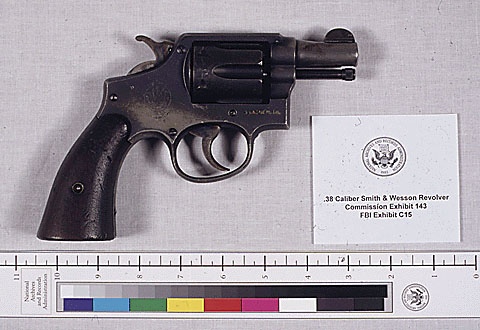 |
[Editor's Note: This article was originally published on August 14, 1998 to address allegations questioning Lee Harvey Oswald's ownership of the .38 caliber Smith & Wesson revolver used to murder Dallas police officer J.D. Tippit.]
Despite considerable evidence to the contrary, some critics have questioned whether Lee Harvey Oswald really owned the revolver used to shoot Officer J.D. Tippit. Recently, allegations have been made based on a 1974 unpublished manuscript by Fred T. Newcomb and Perry Adams titled, Murder From Within.
According to Newcomb and Adams, a 1964 Senate Judiciary Subcommittee looking into mail-order firearms trafficking published a chart which showed that Seaport Traders, the firm Oswald ordered his .38 caliber Smith and Wesson revolver from, never shipped any .38 revolvers to Dallas, Texas in March 1963 - the month of Oswald's order. Newcomb and Adams concluded that "Oswald's gun, in effect, did not exist."
Although critics have clung to Newcomb and Adams' assertions as proof positive of forged documents, cover-ups, and the alleged framing of Oswald, little has been done to substantiate Newcomb and Adams’ claims. In fact, a review of the record shows Newcomb and Adam's allegations to be false and misleading.
Was Oswald a Dodd Committee Investigator?
Newcomb/Adams begin their analysis by pointing out that Oswald ordered both his rifle and pistol "at a time when a Senate subcommittee was investigating the gun mail-order business." [1] The subcommittee referred to is the Senate Judiciary Subcommittee to Investigate Juvenile Delinquency, which was chaired by Senator Thomas J. Dodd. Parts 14 and 15 involved hearings looking into Interstate Traffic in Mail-Order Firearms. Hearings for these sessions were held January 29 and 30; March 7, and May 1 and 2, 1963 (PT.14); as well as, March 26, and April 24 and 25, 1964 (PT.15). [2] Newcomb/Adams note that the subcommittee hired "investigators" to place mail-orders with mail-order gun firms in order to determine if they were following federal and state laws. [3]
There is no doubt that Newcomb/Adams want the reader to believe that Oswald was one of these "investigators" working for the subcommittee when he ordered the rifle and pistol. They point out that both of the firms Oswald ordered from (Klein's and Seaport Traders) were under investigation by the Dodd Committee at the time of the orders. Newcomb/Adams add that Oswald placed these orders despite the fact that both the rifle and revolver were available in several Dallas gun shops at the time. These facts are apparently supposed to be evidence of Oswald's role as an "investigator." [4]
Newcomb/Adams' claim that Oswald's role as an investigator "went further than merely placing orders." According to the unpublished manuscript, "if Oswald could engage in visible and provocative activities and still buy mail-order guns, then the Dodd Committee could use this record" during their hearings. [5] Newcomb/Adams' proceed to list Oswald's "provocative activities." They paint a picture of a young "investigator" pouring through and clipping out mail-order gun coupons, while getting involved in various pro-Castro activities. [6] Yet, all of the "provocative" activities cited by Newcomb/Adams took place after Oswald ordered the weapons. [7] The Dodd Committee, on the other hand, was clearly interested in mail-order guns that had been sold to persons who already possessed a criminal record or were under age. Considering the record, Newcomb/Adams' claim that Oswald's activities fit the profile of one of the Dodd Committee's investigators is unquestionably false.
The Gun That Did Not Exist?
Next, Newcomb/Adams shift focus to Oswald's possession of a .38 caliber Smith & Wesson revolver at the time of his arrest. They cite the Dodd Committee hearings and claim that a chart based on ATF-prepared Seaport Trader records, shows that the gun dealer "did not ship a .38 Smith and Wesson revolver to Dallas in 1963." The chart, Dodd Committee Exhibit 28, is reproduced in the manuscript to underscore the claim. [8] This oft-cited passage has been used as the cornerstone of critical claims that the revolver attributed to Oswald was a "plant," dropped into Oswald's hand at the Texas Theater (or switched with Oswald's "real" gun), and that the paper trail later presented was fabricated to frame Oswald. Yet the record - and Newcomb/Adams' own manuscript - shows that Exhibit 28 was based on an incomplete record.
On April 24 & 25, 1964 the Dodd Committee questioned George W. Rose, owner of Seaport Traders. [9] Rose was chastised by Dodd for failing to turn over all records requested by the Committee. [10] Rose had turned in a list, while the Committee had requested true copies of all invoices representing shipments in the years 1961, 1962, and 1963. [11] Alcohol and Tobacco Tax Unit (ATU) agents went to Rose's office after numerous attempts to get Rose to cooperate, and pieced together the shipping record for the years cited. [12] The Committee found the ATU-compiled record to be incomplete - not all shipments had been included. [13] A chart, based on the incomplete record, was published as part of Committee's hearings:
All of this information was noted by Newcomb/Adams in their manuscript, including a copy of the chart. Yet, Newcomb/Adams concluded that since the "chart shows Seaport did not ship a .38 Smith & Wesson revolver to Dallas in 1963," that "Oswald's gun, in effect, did not exist." [14] Such a conclusion is, of course, inconsistent with the facts.
The chart prepared for the Dodd Committee was based on an incomplete record supplied by Seaport Traders. This fact is discussed throughout Rose's testimony and was duly noted by Newcomb/Adams. How then can Newcomb/Adams substantiate their claim that no .38 Smith & Wesson revolver was shipped to Dallas in 1963? The contradiction seems to have escaped the pair of researchers, as well as their critical supporters.
The fact that Seaport Traders did not turn over to the Dodd Committee a record of the revolver shipment to Oswald was no doubt due to one simple fact: the FBI had taken possession of the documents nearly four months prior to the committee's questioning of Seaport Trader owner, George W. Rose.
Los Angeles based FBI agents searched the records of George Rose & Company, Inc. on Saturday, November 30, 1963 [15] and located the original purchase and shipping records relating to the V510210 revolver, including the mail-order coupon filled out by Oswald. These records were confiscated and sent to the Dallas FBI office the same day. [16] George Rose, owner of Seaport Traders, was subpoenaed by the Dodd Committee on March 2, 1964. At the same time, the Dodd Committee requested true copies of all records pertaining to the years 1961, 1962, and 1963. [17] Two weeks before Rose's April 24th appearance, the committee had still not received the records they had subpoenaed. [18] A week later, ATU agents went to the George Rose & Company premises and pieced together the list which was eventually entered as evidence. [19] This list proved to be an incomplete record of the items requested. [20] Regardless of the state of Seaport Traders' records, the Oswald order could not have been part of those submitted to the Dodd Committee because records for the Oswald order had already been turned over to the FBI.
Shipping Firearms With Railway Express Agency
Newcomb/Adams further charge that "no record exists to show that Hidell/Oswald ever took possession of [the rifle and pistol]." [21] The charge infers that there should be a record, when in fact, none was required. Robert C. Hendon, Vice President in Charge of Operations, Railway Express Agency (REA) did propose to the Dodd Committee a change in the law which would require a consignee to sign a delivery receipt which would be retained by the carrier. [22] But, at the time of the Oswald order, REA Express rules did not require such a signature. Regulations only governed the declaration of the contents of a package and the methodology of delivery. Hendon testified:
"…we have always required that shipments of small arms be handled through our moneys department and that each employee handling such shipments sign a receipt for same. Our rules and regulations require that the contents of every shipment be declared by the shipper and stated in the express receipt. In fact, such declaration is necessary in order to permit the proper ascertainment of transportation charges." [23]
This declaration was duly noted on the Seaport Trader shipping documents: "1 Crtn Pistol." [24]
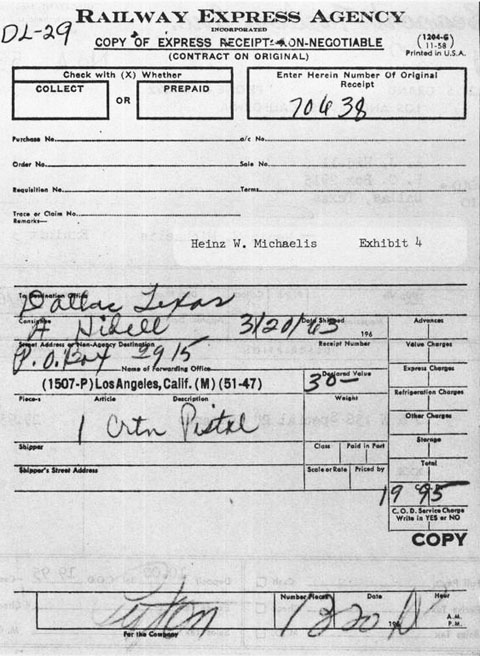 |
Texas law states that one who wishes to purchase a pistol or handgun must first obtain from a justice of the peace, county judge, or district judge of the county of his residence a certificate of good character. [25] Although REA Express would withhold shipments to consignees who failed to display a license or permit in states requiring same, REA regulations do not specifically address whether a shipment would be withheld if a certificate of good character was not presented. [26] Hendon did testify that REA Express "has approximately 32,000 of its own employees, with individuals retiring or leaving the service each day, being replaced by new employees...It would be practically impossible to exercise such close control over and communication with all of our delivery employees to keep within the requirements of the law..." [27] Undoubtedly, there is no way of knowing how many packages containing firearms were delivered without a strict adherence to the law of any particular state.
Newcomb/Adams stated that REA Express was required to "compare a customer's signature with his signature on a legal document, such as a driver's license." [28] They cited the Dodd Committee hearings, yet the page referred to does not support the claim. REA Express did issue general rules and instructions to all employees as they pertain to the shipment of firearms. Those rules are:
Rule 255: Employees must use their best judgment in respect to identification and unless fully convinced of the claimants' identity, must decline to make delivery and should report the circumstance to a superior or agent. The utmost courtesy must at all times be observed in requiring identification.
Rule 257: If consignee is an entire stranger and is unable to obtain personal identification, he must furnish evidence that the shipment was sent to him - first, by correctly describing the contents thereof before shipment is opened, which must be done in the presence of employee effecting delivery; and, second, by surrendering shipping receipt, if in consignee's possession. If employee still has any doubt as to the party being the proper consignee, the goods must be held and agent notified. Letters, postal cards, or bank books should not be accepted as positive identification.
Rule 715: Hand-to-hand check must be made and receipts taken on form 5024 or other approved register forms for the following described shipments: Firearms - small pistols and revolvers. [29]
Oswald could meet Rule 255 by simply showing the false picture identification card in the name of A.J. Hidell - which he had in his possession at the time of his arrest, or meet Rule 257 by describing the contents of the package. Either way, he could take delivery of the revolver, without signing anything.
In the end, Newcomb and Adams' suggestion that Oswald was working for the Dodd Committee is false and unsupported by the events they cite. Their claim that Seaport Trader records show that no .38 Smith & Wesson revolvers were shipped to Dallas in 1963 ignores the fact that records of the Oswald transaction were already in the hands of the FBI at the time of the Dodd Committee Hearings. Finally, contrary to their manuscript, there is a substantial paper trail that connects Oswald to the pistol ordered from Seaport Traders.
How Oswald Ordered the Revolver
The .38 Smith & Wesson revolver used in the Tippit murder was originally purchased by Seaport Traders from Empire Wholesale Sporting Goods, Ltd., on October 13, 1962. Seaport Traders received it on January 3, 1963 and had it modified. [30]
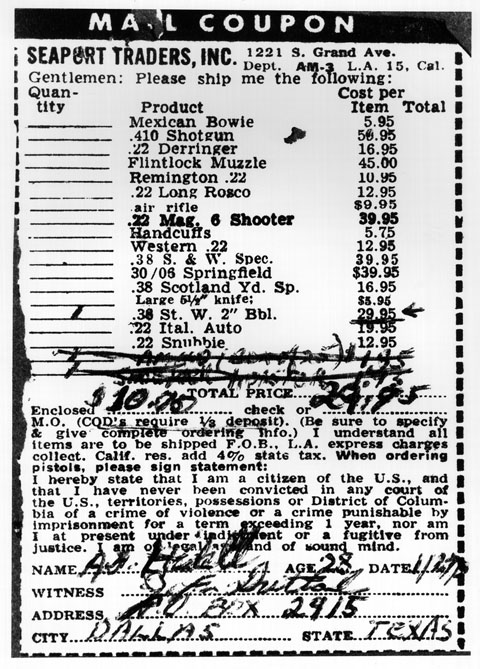 |
Oswald ordered the .38 Smith and Wesson revolver under an assumed name (A.J. Hidell) using a mail-order coupon. [31] The coupon was dated "1/27," no year. The coupon and a $10.00 deposit was received by Seaport Traders on March 13, 1963. The order was filled by Emma Vaughan and shipped March 20, 1963. [32] The package sent contained a modified .38 Smith & Wesson revolver, serial number V510210.
The package was shipped C.O.D. to: A.J. Hidell, P.O. Box 2915, Dallas, Texas, with a balance of $19.95 due, plus C.O.D. charges. Two REA Express documents accompanied the shipment: (1) a description of the contents of the package [33], and (2) a C.O.D. document directing REA to remit the amount collected to Seaport Traders. [34]
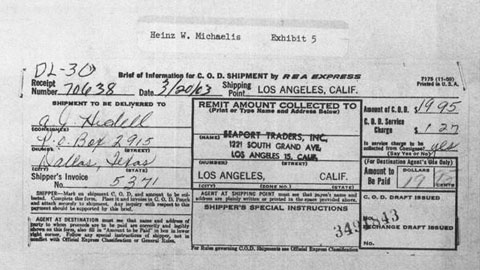 |
Upon arrival at the REA Express office in Dallas, notice was given to the consignee, Hidell. REA Express VP, Robert Hendon testified that in a similar case, "a card was sent to the name and address" on the package. [35] Presumably, a card was sent to Oswald's P.O. Box, notifying him that a package was to be picked up at the REA Express Office, located at 515 South Houston Street - at the north end of the Houston Street viaduct. Oswald's P.O. Box was at the Main Post Office in the Federal Building, 1114 Commerce Street, on the south side, seven blocks east of Houston at Murphy. Both locations were along bus routes easily accessible from Oswald's Neely Street address. [36]
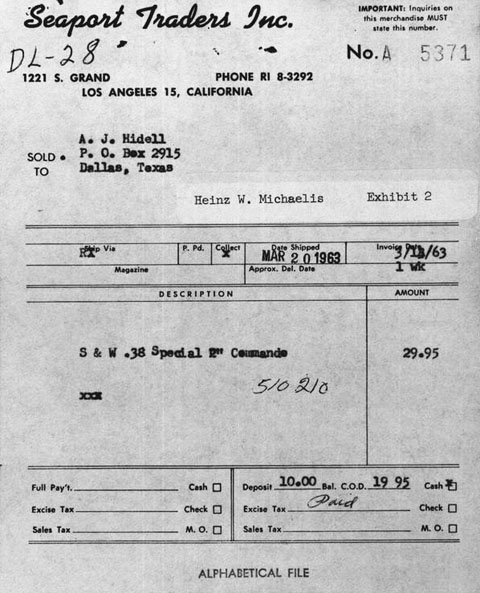 |
Once Oswald received the notification card at his P.O. Box, he simply took a bus back to the REA Express office - presented the notification card, the balance due, and some form of identification - and accepted delivery of the revolver.
After REA Express had delivered the package to Oswald, the C.O.D. remittance document [37] and the amount collected from Oswald, was forwarded to Seaport Traders. Once received, the C.O.D. remittance document was attached to the red copy of the invoice [38], indicating that the money had been collected and the package delivered. [39] These documents were placed in the Seaport Trader files, where they were discovered by FBI agents on November 30, 1963. [40]
The paper trail created by Oswald's purchase of the .38 Smith & Wesson revolver under the name A.J. Hidell is clear and direct. The actions taken by Seaport Traders and REA Express in response to Oswald's order are consistent with each company’s rules and regulations at the time and serve as evidence that the order was processed and delivered as described. The fact that the revolver shipped to Oswald's P.O. Box was in his possession at the time of his arrest is further evidence that the transaction occurred as demonstrated.
In conclusion, there can be no doubt that Oswald ordered and later took possession of the V510210 revolver.
Footnotes:
[1] Murder From Within, Fred T. Newcomb and Perry Adams, 1974, Unpublished Manuscript, p.269
[2] U.S. Congress, Senate, Subcommittee to Investigate Juvenile Delinquency of the Senate Judiciary, Hearings to Study the Interstate Traffic in Mail-Order Firearms, 88th Congress, 2nd Session, 1963, Pt. 14: S1448-11, Pt.15: S1561-1
[3] Newcomb/Adams, op. cit., p.269
[4] Ibid., p.269-270 [Note: Newcomb/Adams also note that Oswald told police during his interrogation that he "bought the revolver in Fort Worth." But, doesn't this contradict their thesis that Oswald is a "mail-order investigator?" Newcomb/Adams never point out that the evidence shows Oswald's alleged Fort Worth purchase is a lie.]
[5] Ibid., p.270
[6] Ibid., p.270
[7] Ibid., p.270-272
[8] Ibid., p.273
[9] Subcommittee to Investigate Juvenile Delinquency, S1561-1, op. cit., pp. 3647-3727
[10] Ibid., pp.3684-3686
[11] Ibid., p.3689
[12] Ibid., p.3689
[13] Ibid., p.3689
[14] Newcomb/Adams, op. cit., p.273
[15] 7H373
[16] FBI RIF 124-10164-10113; 7H379
[17] Subcommittee to Investigate Juvenile Delinquency, S1561-1, op. cit., p.3646, 3686
[18] Ibid., p.3687
[19] Ibid., p.3688
[20] Ibid., p.3689
[21] Newcomb/Adams, op. cit., p.270
[22] Subcommittee to Investigate Juvenile Delinquency, S1448-11, op. cit., p.3463
[23] Ibid., p.3460
[24] Michaelis Exhibit 4
[25] Subcommittee to Investigate Juvenile Delinquency, S1448-11, op. cit., p.3461
[26] Ibid., p.3461
[27] Ibid., p.3463
[28] Newcomb/Adams, op. cit., p.270
[29] Subcommittee to Investigate Juvenile Delinquency, S1448-11, op. cit., p.3466
[30] 7H375
[31] CE135
[32] 7H376; Michaelis Exhibit 4
[33] Michaelis Exhibit 4
[34] Michaelis Exhibit 5
[35] Subcommittee to Investigate Juvenile Delinquency, S1448-11, op. cit., p.3465
[36] The Sixth Floor Museum at Dealey Plaza, Research Center, Dallas White Pages, 1964 [Note: Archivist Gary Mack notes that the REA Express phone number was RI2-5431 and the post office number was RI9-3140.]
[37] Michaelis Exhibit 5
[38] Michaelis Exhibit 2
[39] 7H378-379
[40] 7H378





11 comments:
Excellent article, Dale. Thanks for posting it. And it makes a very good addendum to my blog post below:
http://jfk-archives.blogspot.com/2010/08/dvp-vs-dieugenio-part-42.html
Do you have any idea where this gun is today? I test fired it in l963 and have 2 test fired slugs fired into wet cotton from it. I have kept then in storage for years just as a keepsake but the more I read the more interesting it gets. Interested in Illinois will be my title if we correspond.
The revolver is in storage at the National Archives.
Some years ago I recall learning that a new law went into effect in early 1963 requiring that a form be filled out by a person purchasing a weapon through the mail, and a one dollar fee be charged. I was able to obtain an article on the new law, which appeared in a national magazine (LIFE or SAT. EVE. POST perhaps), which I no longer have.
I'd like to pose a question that subscribes to common sense more than here say.
Some of use believe Oswald was working for the FBI while he was living in Dallas and working at the printing company. There has been much testimony that talked about seeing Lee accepting envelopes from a man in a govt. car, while at the car repair garage next to the printing co. We also know about his association with FBI agent James Hosty. It's my belief the FBI was using him to pose as a perspective gun buyer and purchase firearms through the mail. We know the FBI was investigating this practice and after Johnson was in the White House, he signed leglishlation to outlaw the ability to buy guns through the mail. I think the FBI was using Oswald as a "field agent" to demonstrate how easy it was to buy guns via mail. The reason I believe this is that IF he wanted to buy a rifle to be used to murder someone he would have purchased one that he was familiar with. In the Marine Corp Oswald had much experience with an M1. Question: Why didn't Oswald buy a gun he had experience using, and one that ammunition was readily available? Instead, he bought a cheap, unknown weapon, and it takes ammunition that could only be purchased from only 2 stores in the Dallas/Ft.Worth area? He could have bought ANY gun for many sporting goods stores and had to show any identification. Yes, he used a fake name with the MC, but he still have to give a proper mailing address. To be completely annonomous he never would have used the mail order system.
I believe he bought the Manlichler as an "assignment" for the FBI, and had no plans to kill the president.
Comments?1
Much of what you've written as "fact" is not true. To cut to heart of your question: Why did Oswald buy the Mannlicher-Carcano vs an M1? Ans: The MC was less expensive. (Reminder: Oswald worked menial jobs when he worked at all.) The article above shows the fallacy of the "Oswald as mail-order investigator" argument. Finally, don't forget that common sense is incredibly uncommon.
OK just for my benefit. Why is the gun not new. How can the store sell an old beat up used gun by mail order. Also where is the proof that this old 38 was used to kill Tippit. Wouldnt it have been easy to establish that the gun had been fired that very day that Oswald was arrested with it.
The revolver was WWII surplus - not "an old beat up used gun," as you put it. The proof that the revolver Oswald admitted to be carrying at the time of his arrest and which was taken from his hand by arresting officers (one of which he tried to shoot) was used to kill J.D. Tippit is too numerous to detail here. See: With Malice: Lee Harvey Oswald and the Murder of Officer J.D. Tippit.
What does "There can be no doubt" mean? That there's no way the FBI could have made all that up? That the whole transaction had to have taken place because some paper says so? And paper trails can't be manufactured?
If Oswald wanted guns he could have simply walked 0.6 miles from his work at 411 Elm St. to Cullum & Boren's wholesale and discount guns located at 1509 Elm St. About a 10 minute walk from his work for better guns at a cheaper price. And give up a lot less info that could be used to track him.
It's just nonsense. The police also claimed they found his wallet at J.D. Tippets murder scene at the same time cops identified him by his wallet at the theater. Just like they found his fingerprints at his place of work and identified them as his within an hour, even though only the FBI kept prints in Washington, and it weeks, sometimes even months, for them to run a set of prints in 1963 because it had to be done manually . And the Dallas PD didn't have a set of his prints to run against. No computer= databases or anything else.
And why would cops find an employees fingerprints at his place of work suspicious in the first place? Oswald had 2 wallets with the same id's and a faker id. He also purchased a rifle that doesn't match the one he ordered. The TD rifle isn't even the same one in the backyard photo. He also left work at 12:45 after shooting the president at 12:30. Took a bus and a taxi. Made it home, changed, and walked 13 blocks to kill a cop with a revolver. For which he took the timer to dump the shell evidence that didn't even the bullets. And he did it all in 15 minutes. And he was arrested wearing the same clothes he was at work in, but he went home to change. Yeah... it all has to be true. lol
And they did paraffin tests on Oswald that came back negative, proving that he hadn't fired any guns at all. And yet he was still accused as the shooter by police. Nothing odd about that, right?
“There can be no doubt” that LHO ordered the revolver via the mail because all of the documentation and testimony shown above proves that he did. Your argument – which relies on speculation without foundation – has no basis in fact, otherwise you would have posted it here. And of course, I know that you can’t offer any evidence to support your supposition because none exists. The non-existence of evidence is not “evidence” that something happened, yes? The rest of your accusations are complete fabrications. Why go off topic? I would question here what you are reading – but sadly – I know exactly what you are reading - Internet peddled nonsense. Here’s a short version of the truth of the matter on the subjects you raised (again, all off topic):
(1) A wallet was turned in to police 30-minutes before Oswald was arrested, not at the same time.
(2) The fingerprints left on boxes in the sniper’s nest were not identified as LHO’s “within an hour.” Within an hour of their discovery? (No.) Within an hour of LHO’s capture? (No.)
(3) The location of the fingerprints are suspicious because they were on boxes that had been moved from their original location to the sniper’s lair to serve as a gun rest – not as part of general work being conducted by LHO or anyone else on the sixth floor.
(4) Only LHO’s arrest wallet contained fake ID in the name of “Hidell” – the same name used to order the Mannlicher-Carcano rifle. The rifle shipped to LHO’s P.O. Box was the same one shipped by Klein’s Sporting Goods in Chicago, IL. According to marking’s visible on the stock, it is also the same rifle LHO was holding in photographs taken by his wife, at his insistence.
(5) LHO left the TSBD within 3 minutes of the shooting (i.e., 12:33 pm) – not at 12:45 pm as you claim. During the next 45 minutes – not 15 minutes as you claim – LHO traveled to Oak Cliff, retrieved his revolver and jacket from his room (he did not change clothes, despite his later claims), and walked 0.8 of a mile (10 blocks, not 13) to Tenth Street where he murdered Officer Tippit. Eleven eyewitnesses saw Oswald either shoot the officer or flee the scene.
(6) The shells LHO dumped at the scene as he fled matched the revolver he pulled from his waistband as police attempted to arrest him at the Texas Theater. The bullets in Tippit’s body could not be matched to LHO’s revolver to the exclusion of all other weapons of similar make and model (due to undersized bullets fired through the barrel); nor could LHO’s revolver be excluded from among those that could have fired the bullets. Eyewitness testimony, the discarded shells, and LHO’s own actions in the wake of the Tippit shooting and at the theater seal his guilt in the Tippit murder.
(7) The paraffin tests conducted on Oswald’s hands returned a positive result (not negative as you claim). The paraffin test of LHO’s cheek came back negative, however, experts have stated that the rifle would not be expected to leave residue on his cheek. In addition, a neutron activation analysis of the DPD’s paraffin test, conducted by the FBI, showed that there was indeed a significant amount of residue on Oswald’s hands that was at such a high level that it could only be due to the recent handling or discharging of a firearm and not some other source.
The arguments you make are not uncommon given the amount of garbage found on the Internet on this subject, however, it would better if you looked into the truth of these issues before posting comment here or elsewhere.
Post a Comment